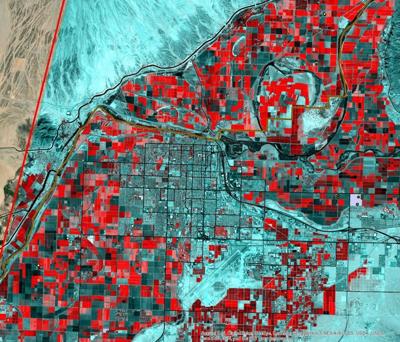Imagery of Yuma crops in 2020 from the Venus satellite. The reds indicate dense, chlorophyll rich vegetation while the blues indicate bare soil and non-vegetated surfaces. U.S. Arid Land Agricultural Research Center
By Katie Sawyer | Maricopa Monitor
MARICOPA — It might be surprising, but southern Arizona is home to one of the largest and most important agricultural regions in the United States. In fact, it’s more than likely that the romaine in your last Postmates order, the L in your BLT sandwich and the spinach currently wilting in your fridge are all from the same agricultural hub to the west of Pinal County: Yuma.
Yuma’s food production tops $2 billion every year, and 90% of the country’s leafy greens come from the arid desert city. As the city’s agriculture grows, so do the needs of the growers. At the U.S. Arid Land Agricultural Research Center, research physical scientist Andrew French has been helping farmers with some much-needed updates to the water usage guidelines.
“The numbers that were used, or are still being used, were done by the University (of Arizona) and by USDA over 20 years ago were really solid, good research,” French said. “But the crop intensity has roughly doubled and yet the water consumption hasn’t changed, which is really a remarkable achievement by the growers. So we need to update those old numbers with new numbers because the yields have gone up dramatically.”










